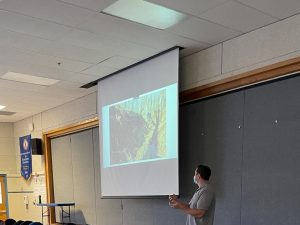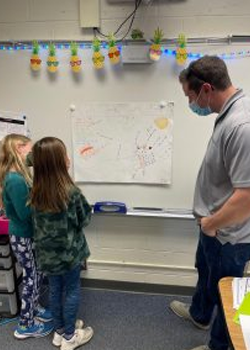Recently GreenVest Ecologist Bobby Miller spoke to a local third grade class about stream restoration and how GreenVest brings innovative methodology to the field of environmental restoration. Bobby discussed his most rewarding project – the Tinkers Creek Stream Restoration Project in Temple Hills, MD – with the students, elaborating on how GreenVest constructs, maintains, and monitors stream restoration jobs.
Bobby began his presentation with the students in the same way most GreenVest projects commence: by identifying a site. He showed them various examples of failing stream channels and explained the various inputs which can cause a stream to fail. The presentation had a focus on urban stream restoration, and how development has a substantial impact on streams in communities just like theirs.

The students learned how stream bank erosion from urban development causes widening and incision of channels leading to the degradation of native plants, disconnection of the stream from the floodplain, and the transport of sediment through the system. Bobby explained that these are some of the factors that go into choosing a project, emphasizing the importance of identifying the site conditions and working as a team to develop a comprehensive restoration plan.
The next portion of the lesson focused on the construction aspect of the project, where Bobby has over 5 years of experience with GreenVest. The students learned how the GreenVest project team uses design plans and heavy machinery to stabilize streams, reshaping the channel into a natural flow emulative of pre-degradation conditions. Bobby used examples of wood toe bank stabilization structures, rock grade control structures, and constructed riffles to give the students a visual representation of how improving bank stability has a positive impact on floodplain connectivity and the overall functionality of the system, like it did at Tinkers Creek.
While this kept the students intrigued, the next topic of flora and fauna made them jump out of their seats with excitement. Bobby shared photos of wildlife and native vegetation he encounters on a daily basis while in the field. Bobby explained how native vegetation and trees can help strengthen waterways and prevent erosion. The students learned about the advantages of biodiversity and how each part of an ecosystem is important. They thought the snapping turtle, salamander, and snake photos were pretty cool, too!

While Bobby spoke to the kids about what GreenVest does every day, he was able to hear about their very own stream restoration projects. The students worked in teams to look at data on a local stream called Scotts Run, then developed a plan on how to protect it. The Scotts Run project was a great way for young minds to come together and develop an action plan, expressing how their very own ideas could protect our waterways. This exercise let the students analyze real-life issues and experiment with creative ways to solve those problems. While the wildlife photos were the students’ favorite part of the presentation, the most rewarding part of Bobby’s day was being able to see how excited the students were to share their projects and help expand upon their new understanding of stream restoration.
It was a very rewarding day for the students, Bobby, and GreenVest. We got to share our mission with the next generation and guide them through an exercise that really emphasizes the importance of all that we do. The students got to learn how important and rewarding it is to work with, restore, and protect the environment from someone who does so daily. Way to go, Bobby!
For a look a Bobby’s virtual presentation last year, check out our blog!



